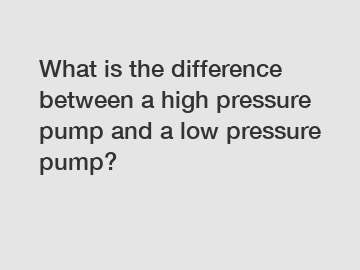What is the difference between a high pressure pump and a low pressure pump?
What is the difference between a high pressure pump and a low pressure pump? This is a question often asked by those who are unfamiliar with fluid dynamics. The key distinction lies in the amount of force these pumps exert on fluids, which ultimately determines their respective applications and functionalities.
High pressure pumps, as the name suggests, are designed to generate greater force or pressure when compared to low pressure pumps. This is achieved through various means such as increased power, enhanced design, or specialized components. These pumps are commonly used in industrial settings where the movement or transfer of fluids requires a significant amount of force. For instance, high pressure pumps are utilized in hydraulic systems, water jet cutting machines, and power washers.
On the other hand, low pressure pumps are designed to exert minimal force on fluids and are typically used in applications where a gentle flow or transfer of liquids is required. These pumps are commonly employed in residential and commercial settings such as HVAC systems, water filtration units, or aquariums. The lower pressure output of these pumps safeguards delicate components or systems from damage while still facilitating the necessary flow of liquids.

The difference in functionality between high pressure and low pressure pumps can be further demonstrated by examining their working principles and design characteristics. High pressure pumps are constructed with robust materials and designed to withstand the immense forces they generate. They often feature reinforced components, such as toughened valves and seals, to handle the increased pressure. In contrast, low pressure pumps can be made from lighter materials since they do not encounter the same intense forces. This results in a cost advantage for low pressure pumps, making them more accessible and economical for widespread use.
The significance of understanding the distinction between high pressure and low pressure pumps lies in the impact it can have on system performance and efficiency. Using the wrong type of pump for a specific application can result in suboptimal performance, reduced lifespan of components, and increased energy consumption. By selecting the appropriate pump based on the desired pressure requirements, overall system efficiency can be improved, leading to cost savings and enhanced reliability.
In conclusion, the difference between a high pressure pump and a low pressure pump lies in the amount of force or pressure they generate. High pressure pumps are designed to exert greater force and are used in industrial applications, while low pressure pumps are utilized in more delicate settings. Understanding this distinction is crucial for selecting the right pump for specific applications, optimizing system performance, and ensuring cost-effectiveness.
For more information, please visit Manual High Pressure PCP Pump, gx-e-cs2 compressor manual, 4500psi stirrup pump for emergency.
140
0
0

Comments
All Comments (0)